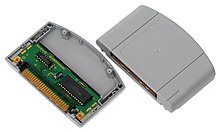 Open and unopened N64 Game Pak | |
| Media type | ROM cartridge |
|---|---|
| Encoding | Digital |
| Capacity | 32–512 Mbit |
| Read mechanism | 5–50 MB/s[1]: 48 |
| Standard | Proprietary |
| Developed by | Nintendo |
| Usage | Nintendo 64 |
Nintendo 64 Game Pak (part number NUS-006) is the brand name of the ROM cartridges that store game data for the Nintendo 64. As with Nintendo's previous consoles, the Game Pak's design strategy was intended to achieve maximal read speed and lower console manufacturing costs through not integrating a mechanical drive, with a drawback of lower per dollar storage capacity compared to a disk. From the console's first year from late 1996 through 1997, Game Pak sizes were 4 to 12 megabytes with a typical third party retail price of US$75.99 (equivalent to about $140 in 2023), then available in 32 megabytes in 1998, and finally 64 megabytes from 1999 onwards.
As with the Famicom Disk System floppy drive of the 1980s, Nintendo sought a higher-capacity and cheaper medium to complement the Game Pak, resulting in the 64DD—a Japan-only floppy drive peripheral which launched late in 1999 and was a commercial failure.
Some developers such as Factor 5, Rare, and Nintendo were supportive of the solid-state medium due to fast read speeds and bank switching. Some other developers had vastly heavier designs, such as the use of full-motion video, but sufficient data compression techniques had not yet been invented and ROM chips were not yet cost-efficient, leading many developers like Square to target CD-ROM based platforms instead.
The Nintendo 64 was the last major home console to have cartridge as its primary storage format. Despite common misconceptions, the Nintendo Switch uses game cards, which are more similar to SD cards, and so differ from cartridges. Portable systems such as the PlayStation Vita, Nintendo DS, and Nintendo 3DS also use game cards.
- ^ Nintendo 64 Programming Manual. Nintendo of America. October 21, 1996. Retrieved November 20, 2015.